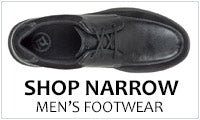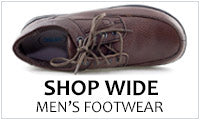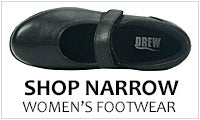If there's a recurring theme in the report, it's that buying the right orthopedic shoe is an investment in foot health. But how do you find an orthopedic shoe that fits properly and provides adequate support, without falling prey to commercial claims by shoe stores and manufacturers that may have no scientific basis?
Start with your own feet, and look at what's already in your closet. Stand barefoot on a piece of paper or cardboard, and trace the shape of each foot. Now take your shoes, one by one, and place them on top of the drawing. If you're like most people, your comfortable" shoes will closely match the outline of your own feet. The shoes that cause pain and most of these will be high heels, if you're a woman - are likely to be narrower than the width of your feet, and maybe even shorter.
FOOT FACTS
Did you know?
- About 9 in 10 women wear shoes that are too small.
- About 8 in 10 women wear shoes that are painful.
- Women are nine times more likely than men to develop a foot problem because of improperly fitting shoes.
- Tight shoes contribute to 9 out of 10 foot problems in women.
Ideally, you would never wear shoes that are too small, too high, or too tight. But if you must have such shoes, wear them as infrequently as possible or you'll increase your risk for foot pain and problems (or exacerbate those you already suffer). The less often you wear tight, ill-fitting shoes, the better. You might want to keep several pairs of shoes on hand; for instance, wearing comfortable, low-heeled pumps around the office or at casual gatherings, and saving fancy, high-heeled shoes for occasional dressy events.
INVEST IN GOOD SHOES
If you're able to afford it, consider investing in a few pairs of shoes that are good for your feet. Buying a pair that you can wear to work, another for dressy occasions, and a third for casual wear, will put you in an ideal position to improve your foot health and do away with many pesky problems that are caused or exacerbated by narrow or tight shoes. Many manufacturers now design shoes with both fashion and comfort in mind. Some manufacturers promote special designs like air bubbles and composite materials (polyurethane, PVC, and the like) in soles to provide more cushioning.
There are a number of things you can look for when choosing a shoe. The bottom line is, how do you feel when you put them on? Trust what your feet tell you. You'll encounter a substantial amount of marketing hype from manufacturers; you can contact the American Podiatric Medical Association (www.apma.org) or visit its Web site, to learn which manufacturers have been awarded the APMA Seal of Acceptance.
For Women, the best shoes are low-heeled - no higher than three-quarters of an inch - with a wide padded heel, a wide toe box, and a sole that provides sufficient cushioning against the impact of walking. The height of a heel is more crucial than its width; in general, the higher the heel, the worse its effect on the foot. It doesn't matter whether the heel is thin and spiky or wide and chunky. One exception is when both toes and heel are raised high, as with platform shoes. Because both toes and heel are elevated, the toes are not subjected to additional stress. But watch your step in platform shoes: you may be more apt to twist your ankle.
Men generally feel most comfortable in athletic shoes, sturdy oxfords, wingtips, loafers, or low-heeled boots. Look for sturdy sole construction that provides support to the foot and cushions against shock. If you have weak or painful ankles, you may want to try a high-top sneaker or boot. If you have diabetes or arthritis, you may need custom-molded shoes or special extra-depth shoes. A few people may benefit from shoes that are custom-designed to address a specific foot problem. People who have diabetes are more likely to fall into this category, as are those who have significant foot deformities. Discuss this option with your foot care specialist.
WHAT TO LOOK FOR
Both men and women benefit from shoes constructed from materials that breathe, which help keep the foot dry and less susceptible to foot fungus. The following 10 guidelines may also be helpful:
- Take a tracing of your foot with you when you go shopping. Place any shoe you think you might buy on top of the tracing. If it's narrower or smaller than the tracing, don't even try it on.
- Wait until the afternoon to shop for shoes - your foot naturally expands with use during the day and may swell in hot weather.
- Wear the same type of socks that you intend to wear with the shoes.
- Have the salesperson measure both of your feet - and get measured every time you buy new shoes. Feet change with age, often growing larger and wider (as the accumulated weight they bear exacts its toll over time). If one foot is larger or wider than the other, buy a size that fits the larger foot.
- Stand in the shoes. Make sure you have at least a quarter - to a half-inch of space between your longest toe and the end of the shoe. This provides enough room for your foot to press forward as you walk, without jamming your toes. Wiggle your toes to make sure there's enough room, and press on the top of the shoe gently to determine where your longest toe lies.
- Walk around in the shoes to determine how they feel. Is there enough room at the balls of the feet? Do the heels fit snugly or do they pinch or slip off? Don't rationalize that the shoes just need to be "broken in" or that they'll stretch with time. Find shoes that fit from the start.
- Trust your own comfort level rather than a shoe's size or description. Sizes vary from one manufacturer to another. And no matter how comfortable an advertisement claims those shoes are, you're the real judge.
- Pay attention to width as well as length. If the ball of your foot feels compressed in a particular shoe, ask if it comes in a wider size. Buying shoes that are a half-size bigger - but no wider - won't necessarily solve the problem.
- Feel the inside of the shoes to see if they have any tags, seams, or other material that might irritate your foot or cause blisters.
- Turn the shoes over and examine the soles. Are they sturdy enough to provide protection from sharp objects? Do they provide any cushioning? Also, take the sole test as you walk around the shoe store: Do the soles cushion against impact? Try to walk on hard surfaces as well as carpet to see how the shoe feels on both.
Printed with the permission of the American Podiatric Medical Association (www.apma.org)



